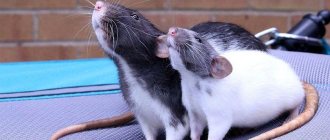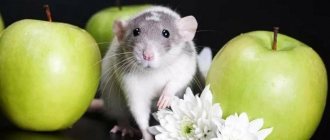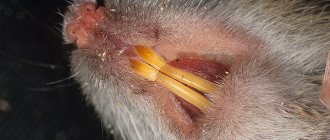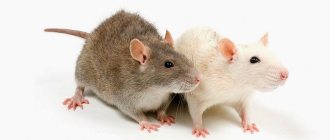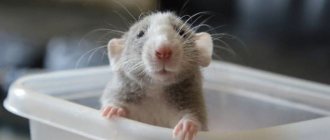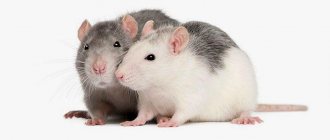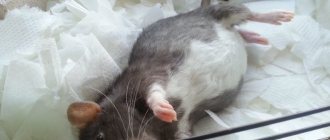- home
- Rat
- Varieties
07/07/2019 Rex is considered one of the most charming breeds of rats. Animals of this species have an attractive appearance, have high intelligence, are friendly and easy to make contact with. All this led to their popularity as pets.
Description of appearance
What makes the animals unique is mainly their curly fur. Otherwise, they are similar to individuals of other breeds.
It is not difficult to recognize Rex by his appearance. In a healthy purebred animal:
- the coat is thick and curly, without bald patches or “rosettes”;
- the curls on the fur are elastic;
- the muzzle is wide and blunt;
- the ears are large, widely set;
- the tail is fluffy.
If you have problems
The Rex breed is an excellent choice for those who dream of having a beautiful and funny animal. Such pets charm with their playful disposition and become attached to their owner. You'll never get bored with them! But what if the rodent suddenly gets sick, becomes sad or loses its appetite?
In this case, the best solution would be to go to the veterinary clinic. Experienced specialists are well versed in the characteristics of all breeds and will give you many valuable recommendations.
Characteristics and Features
On average, adult representatives of the breed have the following parameters:
- height – 8-20 cm for females, 17-25 cm for males;
- weight – 250-500 g for females, 400-850 g for males;
- tail length – up to 12 cm.
The distinctive features of the unique coat of rats include:
- curliness (a la sheepskin);
- lack of undercoat in adults (it falls out of the animal at a young age);
- hardness (including due to the lack of an undercoat layer);
- localization of curliness on the sides and back;
- wrinkling of individual hairs (this is especially pronounced in young animals before the formation of curls on their fur);
- matte color (against the background of the fur of rats of other decorative breeds, the fur of Rex looks dull);
- variety of colors (rex fur comes in a variety of colors, there are even spotted ones, but due to the heterogeneous structure of the fur, the spots are almost indistinguishable).
Rats of this breed have curled not only fur, but even whiskers, which are also noticeably shorter than those of other varieties.
What affects life expectancy
Dumbo rats are unpretentious, so they have managed to adapt to living conditions in many countries. At minimal cost, owners get a cute pet with an easy-going character and extraordinary intelligence.
Conditions of detention
Rats feel great in small cages (60x40x60cm) with metal bars. The cage must have:
- deep plastic tray;
- solid bottom;
- wide doors;
- shelves;
- stairs;
- ropes.
The Dumbo family is very friendly, so several rodents can easily fit into the cage. Together they feel completely comfortable: they do the cleaning and brush out the fur.
A small house inside the cage will add comfort to the Dumbo rats. Babies love to retire and take a nap in silence. Adult pets will appreciate a warm hammock; they will be happy to spend their leisure time there.
Wood or corn filler will help eliminate the specific odor from the rat family. Sometimes owners try to lay napkins or toilet paper on the bottom, but this option is not suitable for rats. Regular cleaning will also help keep the cage clean. Twice a week it is necessary to remove leftover food and used filler, change the water in the drinking bowl, and carry out disinfection.
Dumbos at home should live in a warm room where there are no drafts and moisture. Rats are very sensitive to sharp sounds, blinding light, and overheating. They get tired of people's annoying attention.
Diet
Dumbo rats, unlike rodents that live in the wild, are very sensitive to the consumption of low-quality food. Poor nutrition can easily provoke gastrointestinal disorders and allergies, so owners will have to create a diet according to certain rules.
The rat's menu must include:
It is strictly forbidden to give Dumbo rats fatty and fried food from the master's table, alcohol, sausage, sprouted potatoes, green bananas. The quality of the food should not be in doubt, otherwise the pet will become ill.
Young rats are fed 3–4 times a day. Adult pets need only two meals a day.
It is important to remove uneaten food debris so that the rodent does not eat spoiled pieces.
Hygiene
Dumbo rats are real clean people. They clean their fur and wash themselves, so you don’t have to bathe them often. Water procedures will be required if the pet gets very dirty. Rats, unlike other pets, love to swim. They can splash around in warm water for a long time.
Bathing is carried out with special shampoos in a warm room without drafts. It is necessary to ensure that water does not get into your pet’s ears, which can lead to hearing loss. After bathing, the rat is wrapped in a warm towel and dried well. If the room is cold, it is better to dry the fur with a warm stream from a hairdryer.
One of the dangers of swimming is hypothermia. A frozen rat can easily catch a cold. Therefore, in the cold season, the doors and windows in the room are tightly closed, and a heater is placed near the cage.
Entertainment
Caring for and maintaining Dumbo rats means not only food and a cozy home, but also a kind of gym. In the absence of the owner, the animals entertain themselves by climbing ropes and rope ladders, and passing through tunnels. Some craftsmen make toys for pets on their own.
Subspecies
The breed includes three subspecies. The main one is the breed standard described above. The other two are intrabreed subspecies:
- Dumbo Rex (the variety is named after the famous baby elephant from the Disney cartoon, so the peculiarity of the Dumbo Rex rat is immediately clear from its name - these are large round ears, the fur of the animal does not differ from the breed standard);
- Double Rex (a semi-hairless variety - the rat looks as if it had been shorn, the fur of the animal is very short, sticking out in different directions due to curliness, otherwise the appearance of the animal does not differ from the breed standard).
How to extend your pet's life
Based on the fact that the average lifespan of a rat is 2 years, you can try to increase this period by surrounding the animal with attention and care
Disease Prevention
It is easier to prevent the cause of the disease than to deal with the consequences. Proper care will avoid many problems. The rat cage should be cleaned and washed regularly using a weak disinfectant solution. The water in the drinking bowl must be clean and changed every day. It is better to use regular filtered water. You should regularly remove food debris that is decomposing and can cause illness.
Avoid pine filler
. It is not suitable for rodents. You can use corn or simply lay toilet paper for the animals.
Don't overcool your pet
. Drafts and improper placement of the cage can cause a cold.
Place the newly acquired animal separately in quarantine so that it does not infect the old inhabitants of the cage. Purchase an ultraviolet lamp to disinfect the room. Find a veterinarian who specializes in rodents to contact if you are sick.
Health monitoring
The habit of observing your pets will allow you to learn a lot about them, and at the same time notice the signs of an incipient disease. If the animal is not eating well, has stopped playing, looks lethargic, or has discharge from the nose or eyes, and its fur has become disheveled and unkempt, consult a doctor immediately. Infectious diseases occur very quickly in rodents, so there is a risk of losing the animal. Diarrhea not associated with an excess of vegetables also indicates illness.
Inspect your pet's stool, it may contain helminths - worms. You should be wary of the fact that the rat itches intensely - there is a risk of parasitic diseases. A rodent dragging its hind legs also requires attention - this is a common problem for aging rats. Older animals are susceptible to tumors, heart attacks and strokes.
Conditions of detention
How many years domestic rats live is directly related to their living conditions. This is affected by:
cage size - at least 60x40x50 cm (width-length-height) for 2 animals, and for females it is better to make high multi-level cages, and for males the floor area is important; cage equipment – hammocks, shelves, etc.; neighborhood - rats are pack animals, so it is better to keep two, three, but no more than four same-sex animals together; the possibility of walking on a fenced area or on a sofa; sports activity in the form of an obstacle course in the play area; owner's attention. Rats are gentle creatures that become attached to humans; security of space - shelter, as a prevention of stress.
If a pet rat lives in such a room, and even with regular walking, then this helps it maintain health and good mood
If a pet rat lives in such a room, and even with regular walking, then this helps it maintain health and good mood.
Proper nutrition
A balanced diet of grains, small amounts of fruits and vegetables with the occasional addition of protein will allow animals to feel good. You cannot feed animals table food or overfeed them with high-calorie foods. To prevent dental diseases, you need to keep a mineral stone in a cage to grind down your incisors.
If a decorative rat lives comfortably at home, then it has a greater chance of reaching a “respectable” age. Although a pet's lifespan is short, it will fill the owner's life with vivid impressions and deep affection.
Previous Features and habits of ratsHow many hours do domestic rats sleep per day Next Features and habits of ratsWeight and size of rats from small to adult - table by age
Nutrition
The rat diet should be based on ready-made food. Mandatory feed additives include cereals and vitamins. You can feed your pet with the following:
- half-boiled porridge;
- fruits (especially apples and plums);
- greens;
- boiled lean chicken;
- boiled eggs;
- fruits;
- seeds;
- sour cream;
- kefir
Unsweetened crackers can be given as a treat.
What to feed a rat
The health and well-being of an animal directly depend on a properly selected diet. Experienced breeders recommend using specialized food as the basis for the mouse menu, because such compositions are created specifically for rodents and are enriched with all the necessary micro- and macroelements. But for proper nutrition, you will need to include additional natural foods in your pet’s diet:
- vegetables - zucchini, broccoli, pumpkin, cucumber, cauliflower;
- fruits - apple, banana, pear, apricot, avocado;
- berries - raspberries, strawberries, wild strawberries, currants, gooseberries;
- vegetables - parsley, lettuce, celery, dandelion, plantain;
- lean meat - turkey, beef, chicken breast, rabbit;
- lean fish and seafood - shrimp, crabs, squid, mussels;
- fermented milk products - fermented baked milk, kefir, low-fat cottage cheese, natural yogurt, varnet, yogurt.
In addition, 1-2 times a week you can pamper your fluffy hedgehog with various treats, purchased at a pet store or prepared yourself. Rex will like seeds and nuts, dried fruits, grain sticks, unspiced crackers, dried insects and mealworms, and twigs from fruit trees.
Also, to strengthen the immune system, you can add specialized mineral and vitamin complexes to the feeder. For example, Doctor ZOO, Beaphar, Farmavit NEO, Mineral Block.
It is worth noting that it will be necessary to completely exclude human food from the diet of mice: any ready-made meals, sweets, baked goods, fast food, sausages, cheeses, smoked, salted and dried fish, canned food.
Character in everyday life
Curly-haired pets are very curious - they crawl under doors and into all the cracks in the apartment. When letting the animal out of its cage for a walk, you need to keep an eye on it - do not accidentally crush it under the door or step on it. If your pet manages to escape observation and escape, urgently put all your efforts into searching. And where to start searching if a rat has escaped, read here.
Rexes are agile creatures. They need spacious housing so they can run around. These are social animals, so it is recommended to have more than one individual.
The cage should have:
- swing;
- a shelter in the form of a house where the pet can hide;
- labyrinths in which you can climb;
- toys that the rodent can do in his free time from eating and sleeping.
Arrangement of the cage
A rat in a cage needs to have fun. It is necessary to regularly refresh the food and clean the cage. These are clean animals. The cage must be disinfected twice a month. Serve the bulk of the food in the evening. But the rex must always have clean drinking water.
And then the cheerful curly-haired Rex rat will live up to the owner’s hopes and will be interesting to play with. You can choose a pet of any color. Rexes have a friendly character and a pretty appearance.
Did you like the article? Share with friends: [supsystic-social-sharing id=”1"]
- Related Posts
- Types and breeds of decorative rats
- How rats laugh and why they do it
- Keeping and caring for a pet rat
« Previous entry
By coat color
Decorative rats are also conventionally divided into several groups according to the type and color of their coat.
Homogeneous (Self)
Rodents of this species have absolutely the same coloring throughout their entire body. Rats are black, white, blue (color with a silver tint. Russian blue and smoky blue are also found. They are very similar in color, the former have a dark color and a light belly, and the latter have a more pronounced blue tint.
Rats in gray-brown tones with a silver-bluish tint with cherry eyes are called mink. There is also an American mink species, these animals have a darker eye shade.
Light gray color with a cool blue tint. The eyes are black or dark red. This is a platinum shade.
Blue, platinum rat
The beige color of the rats resembles coffee with milk. And completely white animals with red eyes are usually called albinos.
Very beautiful coloring of rats - champagne. This species of animal has a light, slightly pinkish color. The eyes are pink.
Russian silver is an interesting light gray color with a blue tint. This variety is characterized by fuzzy ripples of color.
The main color of the “dav” species is pale gray with a pinkish tint. It has a characteristic light ripple. Rat "Lilak" - light ash color, slightly mixed with chestnut color. Eyes black or dark cherry.
Officially unrecognized colors of domestic rats:
- Chocolate;
- Russian beige;
- Caramel.
Ticked colors
They are distinguished by uneven coloring of the hairs, that is, there are places on them that may have pigments of different colors.
Agouti
This coloring is characterized by a beautiful chestnut color. Some hairs are black. Short and medium hairs have bands. They must be free of orange and yellow, and it is better if they are of the lightest shades.
The base color consists of a dark gray or light brown tint. The ends of the hairs are black and the belly is silver-gray.
Rat – Agouti
There is also a blue agouti - the belt of hairs can be red and brown, and the belly is light gray-blue with inclusions of silver hairs.
Incredibly beautiful shade of platinum agouti. This bright color is combined using two colors: light gray and beige with a cool blue tint. Each hair has a light blue base with a beige edge. The belly is light silver.
Amber (Amber)
Rich color of yellow and orange shades. Each hair has an ivory border. The guard hairs have a silvery tint. The undercoat is cream and the belly is light. The eyes are pink.
Amber color
Cinnamon
Rodents are colored in red-brown tones with inclusions of darker guard hairs, which have bright golden and red edgings. The belly is gray with silver, and the eyes are black or cherry.
Faun
These rodents have a beautiful coffee color with a golden tint with the inclusion of silvery guard hairs. There is a not very expressive golden-red pattern. The belly is cream and silver, and the eyes are the color of dark ruby.
Breed – Fawn
Topaz
This color is similar to the Fawn color, however, it is not as rich and has a lighter undercoat.
Pearl
This species has a light, silvery tint. Eyes black or dark ruby. There are also 2 subspecies: Pearl cinnamon and Pearl blue. The first color consists of three colors: beige, golden and light gray.
Overall, it is golden with a silvery tint. Eyes black or dark ruby. The second color is light with beige and gray shades. Each hair is silver-gray in color. The belly is grayish-beige, and the eyes are black or dark cherry.
Pearl rat
Silver colors
The uniqueness of this color lies in the variation of silver and colored hairs in the same number. It should be obvious and designed to create the impression of brilliance and sparkle. If there are inclusions of white hairs, then the color is no longer recognized as silver.
- Silver-black. The color of such rodents is deep black with uniform inclusions of silver hairs. The eyes are black.
- Silver blue. The color is gray with a blue tint. Individual hairs are silvery-white. The undercoat is light gray with a blue tint.
- Silver mink. Deep brown color with a gray tint. Has the same amount of silver and brown hairs.
Combined colors
This category includes the colors of rats, consisting of a combination of several colors.
Siamese
The animal has a beige color that darkens in the back of the body, moving from the lower back to the tail, and also from the belly to the upper back. The tail is dark at the base along its entire length. The rodent has brown spots on its ears, legs up to the elbows and on its face.
Siamese rat
Additionally there are:
- Siamese with black eyes. The color is standard for this species, the eyes are dark.
- Siamese blue. It has a cream color with a silver tint that darkens on the back of the body.
- Siamese Russian Blue. The color is beige, gradually darkening in the back of the body. There are dark brownish spots.
Himalayan
Snow-white color, which is uniform throughout the body. There are dark brown spots. The eyes are red. The paws are slightly colored. The Black-eyed Himalayan is a white rodent with cream spots.
Burmese
Has an even brown color. Wheaten Burmese - the animal has a sandy color with spots of slightly darker tones. The hairs have a yellowish band and a light silver-gray belly.
Breed – Burmiz
Sable
Coffee coloring with dark spots on the paws.

